Assessing Cement Stabilized Rammed Earth Durability in A Humid Continental Climate
Abstract
:1. Introduction
1.1. Rammed Earth
1.2. Characteristics of a Humid Continental Climates
1.3. Standardized Properties of Rammed Earth
1.4. Aim of the Research
2. Materials and Methods
2.1. Materials
2.2. Methods
2.2.1. Preparation of Samples
2.2.2. Composition of the Soil Mixtures
- -
- the higher the gravel content of the mixture, the lower the optimum moisture content;
- -
- the higher the content of the clay fraction in the mixture, the higher the optimal moisture content; and,
- -
- the higher the content of cement added to the mixture, the higher the optimal moisture content.
2.2.3. Compressive Strength
2.2.4. Methods for Durability Assessment and Criterial Values
2.2.5. Linear Shrinkage
2.2.6. Water Erosion Resistance
2.2.7. Wet to Dry Compressive Strength Ratio
2.2.8. Frost Resistance
3. Results
3.1. The Analysis of Linear Shrinkage Deformation Development
3.2. Influence of Soil Mix Characteristics on Water Erosion Resistance
3.3. Wet to Dry Compressive Strength Ratio Investigation
3.4. Rammed Earth Frost Resistance
4. Discussion
5. Conclusions
- -
- content of 30% gravel fraction (2-4 mm) in the soil mixture, which is confirmed by the recommended grain size are softening index a given in the literature, and
- -
- stabilization of the mixture with CEM I 42.5 R cement in the amount of not less than 9% of other dry components.
Author Contributions
Funding
Conflicts of Interest
References
- Pérez-Lombard, L.; Ortiz, J.; Pout, C. A review on buildings energy consumption information. Energy Build. 2008, 40, 394–398. [Google Scholar] [CrossRef]
- Huberman, N.; Pearlmutter, D. A life-cycle energy analysis of building materials in the Negev desert. Energy Build. 2008, 40, 837–848. [Google Scholar] [CrossRef]
- Hall, M.R.; Najim, K.B.; Keikhaei, P. Soil stabilization and earth construction: Materials, properties and techniques. In Modern Earth Buildings; Woodhead Publishing Limited: Cambridge, UK, 2012; pp. 222–255. [Google Scholar]
- Schroeder, H. Modern earth buildings codes, standards and normative development. In Modern Earth Buildings; Woodhead Publishing Limited: Cambridge, UK, 2012; pp. 72–106. [Google Scholar]
- Hall, M.R.; Swaney, W. European modern earth Construction. In Modern Earth Buildings; Woodhead Publishing Limited: Cambridge, UK, 2012; pp. 650–687. [Google Scholar]
- Anysz, H.; Narloch, P. Designing the Composition of Cement Stabilized Rammed Earth Using Artificial Neural Networks. Materials 2019, 12, 1396. [Google Scholar] [CrossRef] [Green Version]
- Arrigoni, A.; Grillet, A.-C.; Pelosato, R.; Dotelli, G.; Beckett, C.; Woloszyn, M.; Ciancio, D. Reduction of rammed earth’s hygroscopic performance under stabilisation: An experimental investigation. Build. Environ. 2017, 115, 358–367. [Google Scholar] [CrossRef]
- Reiterman, P.; Pazderka, J. Crystalline coating and its influence on the water transport in concrete. Adv. Civ. Eng. 2016. [Google Scholar] [CrossRef] [Green Version]
- Narloch, P.; Woyciechowski, P.; Kotowski, J.; Gawriuczenkow, I.; Wojcik, E. The Effect of Soil Mineral Composition on the Compressive Strength of Cement Stabilized Rammed Earth. Materials 2020, 13, 324. [Google Scholar] [CrossRef] [Green Version]
- Peel, M.C.; Finlayson, B.L.; Mcmahon, T.A. Updated world map of the Köppen-Geiger climate classification. Hydrol. Earth Syst. Sci. 2007, 11, 1633–1644. [Google Scholar] [CrossRef] [Green Version]
- Ahrens, D.; Henson, R. Meteorology Today. In An Introduction to Weather, Climate and the Environment, 11th ed.; Cengage Learning: Boston, MA, USA, 2016; pp. 491–492. [Google Scholar]
- NZS 4298:1998 Materials and Workmanship for Earth Buildings; Standards New Zealand: Wellington, New Zealand, 1998.
- Jimenez Delgado, M.C.; Canas Guerrero, I. The selection of soils for unstabilised earth building: A normative review. Constr. Build. Mater. 2007, 21, 237–251. [Google Scholar] [CrossRef]
- Minke, G. Building with Earth. Design and Technology of a Sustainable Architecture; Birkhäuser– Publishers for Architecture: Kassel, Germany, 2006. [Google Scholar]
- Middleton, G.F.; Schneider, L.M. CSIRO Bulletin 5 Earth-Wall Construction, 4th ed.; CSIRO Division of Building, Construction and Engineering: Sydney, Australia, 1987. [Google Scholar]
- EBAA. Building with Earth Bricks and Rammed Earth in Australia; Earth Building Association of Australia: Wangaratta, Australia, 2004. [Google Scholar]
- Walker, P. HB 195-2002. The Australian Earth Building Handbook; Standards Association of Australia: Sydney, Australia, 2002. [Google Scholar]
- NBR 13553. Materiais para emprego em parede monolítica de solo-cimento sem função estrutural; Associação Brasileira de Normas Técnicas ABNT: Rio de Janeiro, Brazylia, 1996. [Google Scholar]
- Lehmbau Regeln—Begriffe, Baustoffe; Bauteile: Wiesbaden, Germany, 2009.
- IS: 2110. Code of Practice for in Situ Construction of Walls in Buildings with Soil-Cement; Indian Standards: New Delhi, India, 1980; reaff. 1998. [Google Scholar]
- IS: 13827. Improving Earthquake Resistance of Earthen Buildings—Guidelines; Indian Standards: New Delhi, Indian, 1993; reaff. 1998. [Google Scholar]
- PCH-2-87. Вoзведение малoэтжных зданий и сooружений из грунтoцементoбетoна (ang. Building of Low-Storied Houses with Stabilized Rammed Earth); State Building Committee of the Republic of Kyrgyzstan/Gosstroi of Kyrgyzstan: Frunse (Bischkek), Republic of Kyrgyzstan, 1988. [Google Scholar]
- NZS 4297:1998. Engineering Design of Earth Buildings; Standards New Zealand: Wellington, New Zealand, 1998. [Google Scholar]
- NZS 4299:1998. Earth Buildings Not Requiring Specific Design; Standards New Zealand: Wellington, New Zealand, 1998. [Google Scholar]
- 14.7.4 NMAC. New Mexico Earthen Building Materials Code; New Mexico Regulation and Licensing Department: Santa Fe, NM, USA, 2009. [Google Scholar]
- ASTM. E2392/E2392M. Standard Guide for Design of Earthen Wall Building Systems; ASTM International: West Conshohocken, PA, USA, 2010. [Google Scholar]
- ASTM. D560. Standard Test Methods for Freezing and Thawing Compacted Soil-Cement Mixtures; ASTM International: West Conshohocken, PA, USA, 2003. [Google Scholar]
- ASTM. D559-96. Standard Test Methods for Wetting and Drying Compacted Soil-Cement Mixtures; ASTM International: West Conshohocken, PA, USA, 2015. [Google Scholar]
- SAZS. 724. Standard Code of Practice for Rammed Earth Structures; Standards Association of Zimbabwe: Harare, Zimbabwe, 2001. [Google Scholar]
- BN-62/6738-01. Masy Cementowo-Gliniane z Wypełniaczami; Wydawnictwa Normalizacyjne “ALFA”: Warsaw, Poland, 1992. [Google Scholar]
- BN-62/6738-02. Budownictwo z Gliny—Masy Gliniane; Wydawnictwa Normalizacyjne “ALFA”: Warsaw, Poland, 1992. [Google Scholar]
- MOPT Tapial. Bases para el diseño y construcción con tapial; Secretaría General Técnica: Madrid, Spain, 1992. [Google Scholar]
- Hall, M.R. Assessing the environmental performance of stabilized rammed earth walls using a climatic simulation chamber. Build. Environ. 2007, 42, 139–145. [Google Scholar] [CrossRef]
- Hall, M.; Allinson, D. Analysis of the hydrothermal function properties of stabilized rammed earth materials. Build. Environ. 2009, 44, 1935–1942. [Google Scholar] [CrossRef] [Green Version]
- Narloch, P.L.; Woyciechowski, P.; Rosicki, Ł.; Cichocki, D. Ziemia ubijana stabilizowana cementem jako materiał konstrukcyjny—Ocena nasiąkliwości. Przegląd Bud. 2015, 5, 22–25. [Google Scholar]
- Hall, M. The Mechanisms of Moisture Ingress and Migration in Rammed Earth Walls. Ph.D. Thesis, Sheffield Hallam University, Sheffield, UK, 2004. [Google Scholar]
- Narloch, P.L.; Woyciechowski, P.; Jęda, P. The influence of loam type and cement content on the compressive strength of rammed earth. Arch. Civ. Eng. 2015, 61, 73–88. [Google Scholar] [CrossRef] [Green Version]
- Narloch, P.; Hassanat, A.; Tarawneh, A.S.; Anysz, H.; Kotowski, J.; Almohammadi, K. Predicting Compressive Strength of Cement-Stabilized Rammed Earth Based on SEM Images Using Computer Vision and Deep Learning. Appl. Sci. 2019, 9, 5131. [Google Scholar] [CrossRef] [Green Version]
- Hall, M.; Djerbib, Y. Rammed earth sample production: Context, recommendations and consistency. Constr. Build. Mater. 2004, 18, 281–286. [Google Scholar] [CrossRef]
- Narloch, P.L.; Lidner, M.; Kunicka, E.; Bielecki, M. Flexural Tensile Strength of Construction Elements Made out of Cement Stabilized Rammed Earth. Procedia Eng. 2015, 111, 589–595. [Google Scholar] [CrossRef]
- Maniatidis, V.; Walker, P. A Review of Rammed Earth Construction, Innovation Project “Developing Rammed Earth for UK Housing”; Natural Building Technology Group, Department of Architecture & Civil Engineering, University of Bath: Bath, UK, 2003. [Google Scholar]
- Houben, H.; Guillaud, H. Earth Construction—A Comprehensive Guide, 2nd ed.; Intermediate Technology Publications: London, UK, 1996. [Google Scholar]
- Wiłun, Z. Zarys Geotechniki; Wydawnictwa Komunikacji i Łączności: Warszaw, Poland, 2013; Volume 10. [Google Scholar]
- PN-EN 13286-2:2010. Unbound and Hydraulically Bound Mixtures. Test Methods for Laboratory Reference Density and Water Content. Proctor Compaction; Polish Committee for Standardization: Warsaw, Poland, 2010. [Google Scholar]
- PN-EN 12390-3:2019-07 Testing Hardened Concrete. Compressive Strength of Test Specimens; Polish Committee for Standardization: Warsaw, Poland, 2019. [Google Scholar]
- Arendarski, J. Trwałość i niezawodność budynków mieszkalnych; Arkady: Warsaw, Poland, 1978. [Google Scholar]
- Guettala, A.; Abibsi, A.; Houari, H. Durability study of stabilized earth concrete under both laboratory and climatic conditions exposure. Constr. Build. Mater. 2006, 20, 119–127. [Google Scholar] [CrossRef]
- PN-B-06714–23:1984: Kruszywa mineralne. Badania—Oznaczanie zmian Objętościowych Metodą Amslera; Polish Committee for Standardization: Warsaw, Poland, 1984. [Google Scholar]
- Keable, J.; Keable, R. Rammed Earth Structures: A Code of Practice, 2nd ed.; Practical Action: Rugby, UK, 2011. [Google Scholar]
- Heathcote, K.A. Durability of earthwall buildings. Constr. Build. Mater. 1995, 9, 185–189. [Google Scholar] [CrossRef]
- PN-B-06265:2018-10/Ap1:2019-05. Concrete—Specification, Performance, Production and Conformity—National Annex to PN-EN 206+A1:2016-12; Polish Committee for Standardization: Warsaw, Poland, 2019. [Google Scholar]
- PN-EN 206:2013+A1:2016. Concrete—Specification, Performance, Production and Conformity; Polish Committee for Standardization: Warsaw, Poland, 2016. [Google Scholar]
- Woyciechowski, P.; Narloch, P.L.; Cichocki, D. Shrinkage characteristics of cement stabilized rammed earth. In Proceedings of the XXVI R-S-P Seminar Theoretical Foundation of Civil Engineering, MATEC Web of Conferences 117:00178, Bangalore, India, January 2017. [Google Scholar]
- Bui, Q.B.; Morel, J.C.; Reddy, B.W.; Ghayad, W. Durability of rammed earth walls exposed for 20 years to natural weathering. Build. Environ. 2009, 44, 912–919. [Google Scholar] [CrossRef]
- Narloch PLWoyciechwski, P.; Dmowska, E.; Halemba, K. Durability assessment of monolithic rammed earth walls. Arch. Civ. Eng. 2015, 61, 73–88. [Google Scholar] [CrossRef] [Green Version]
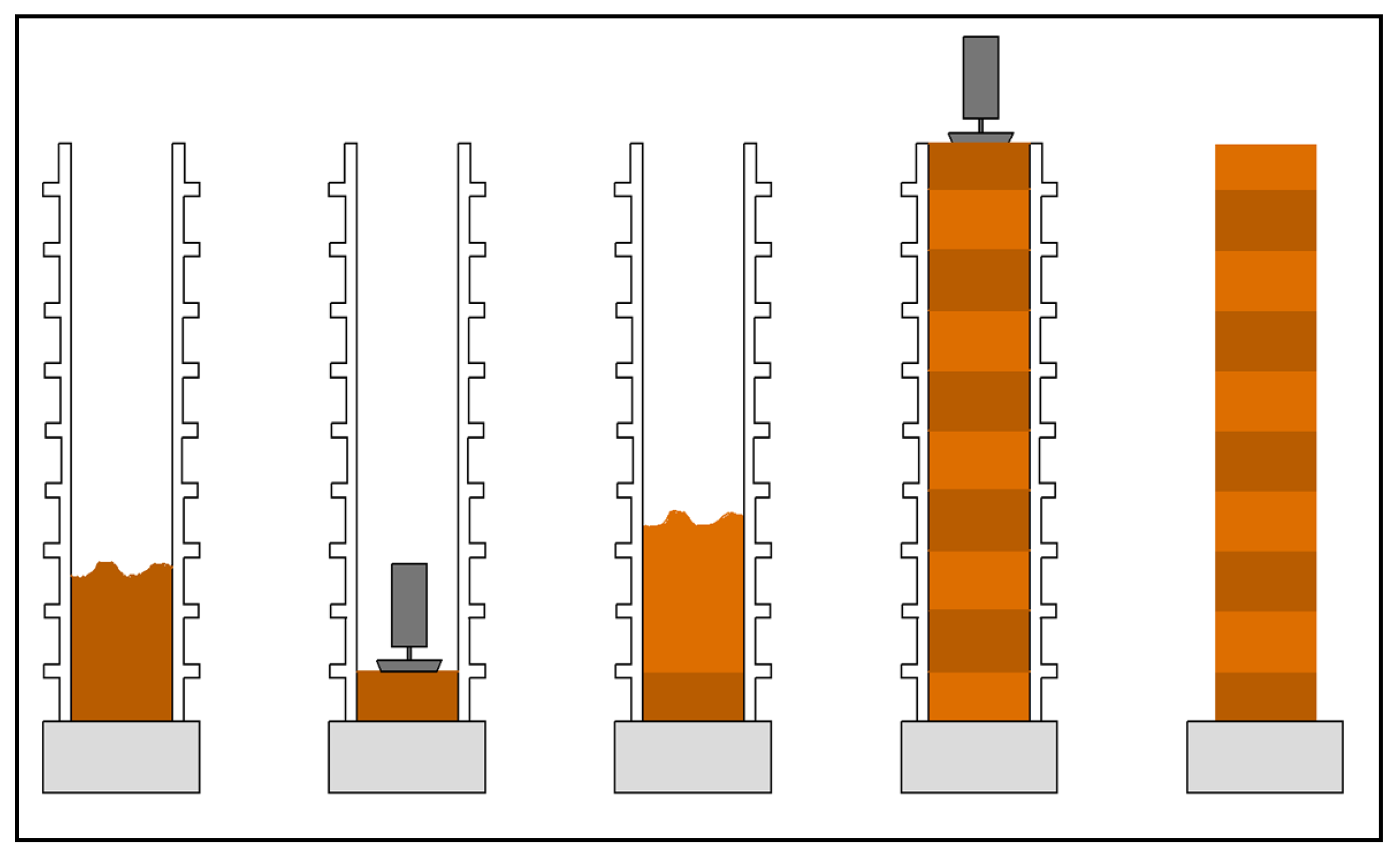
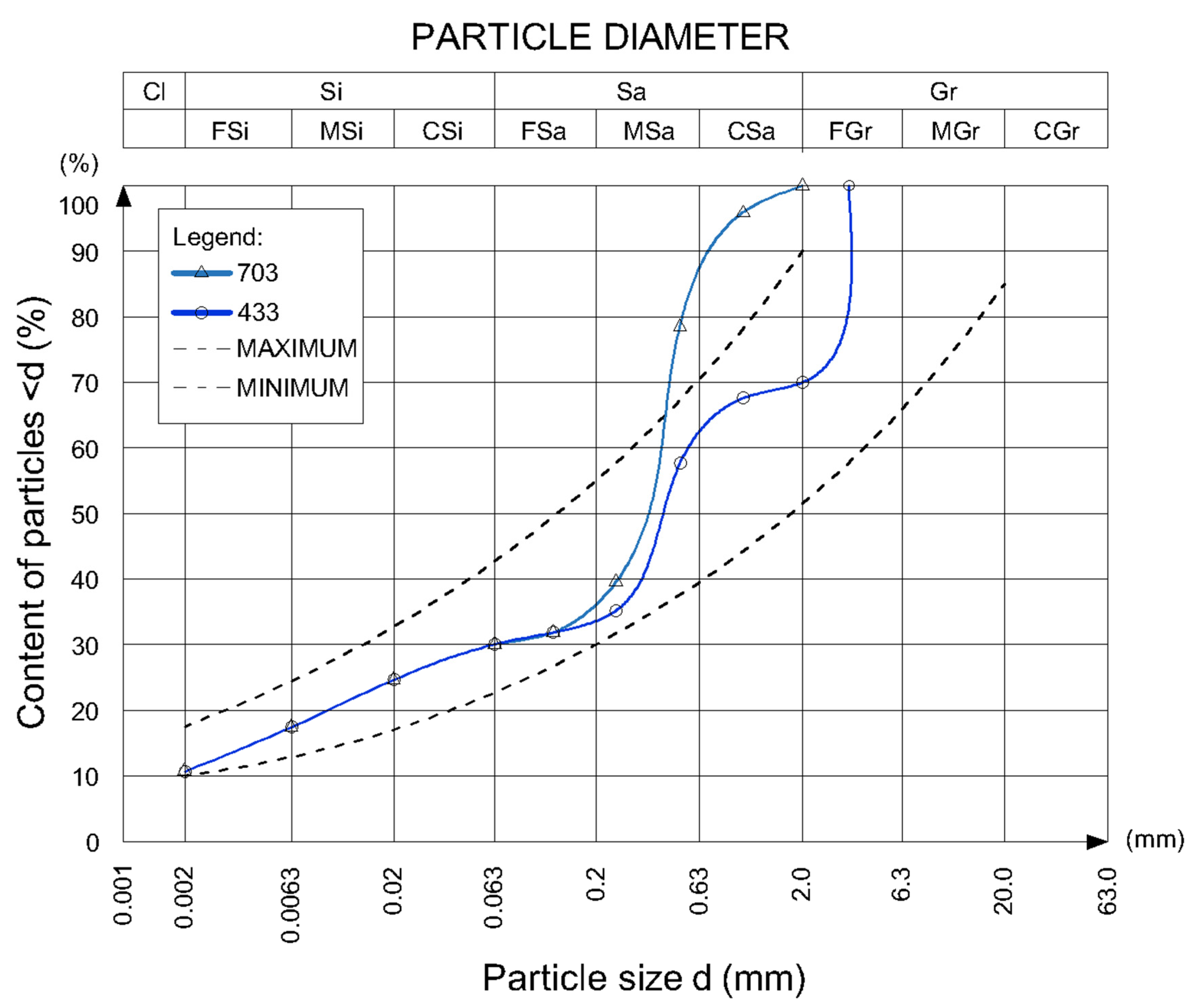
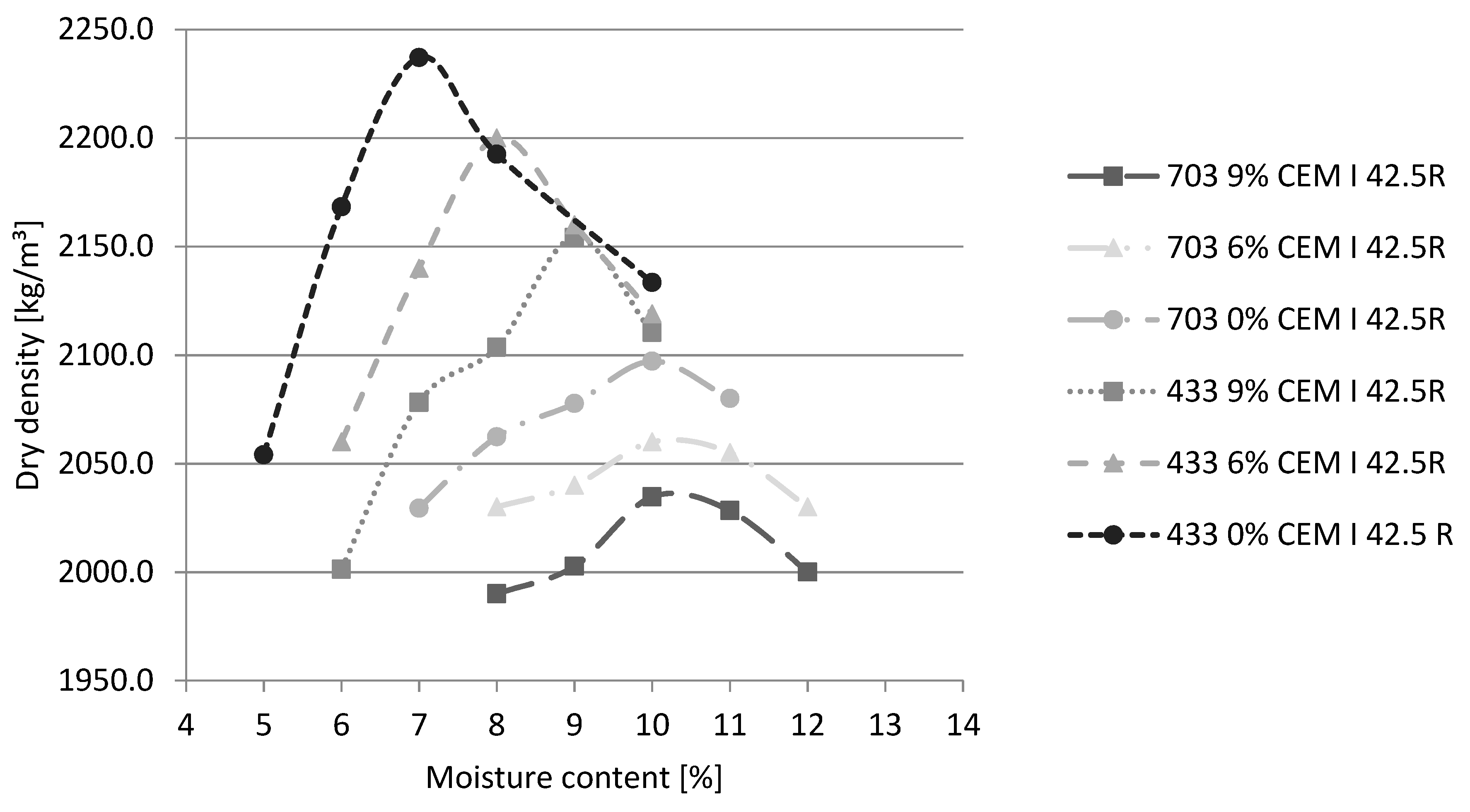
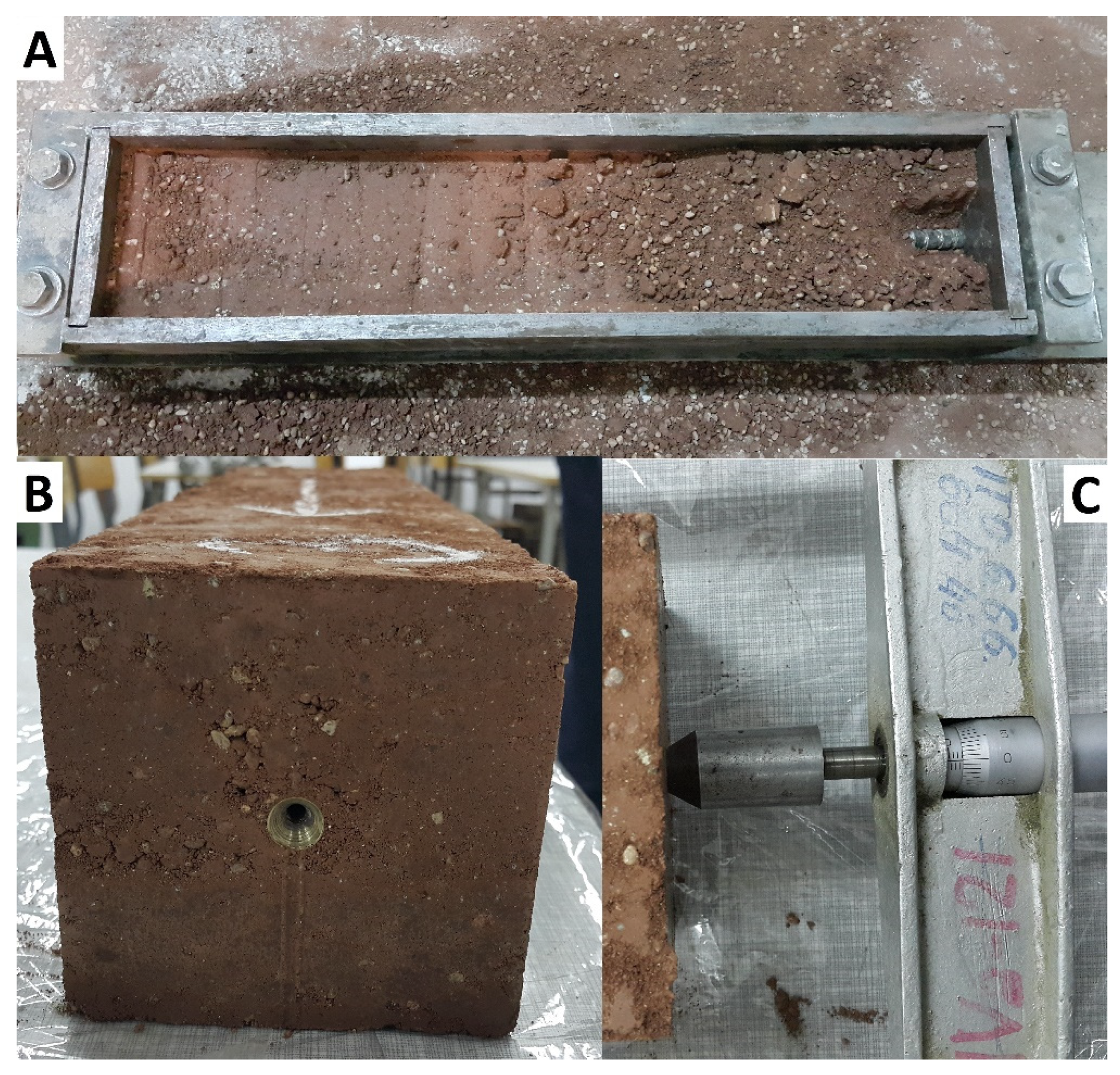

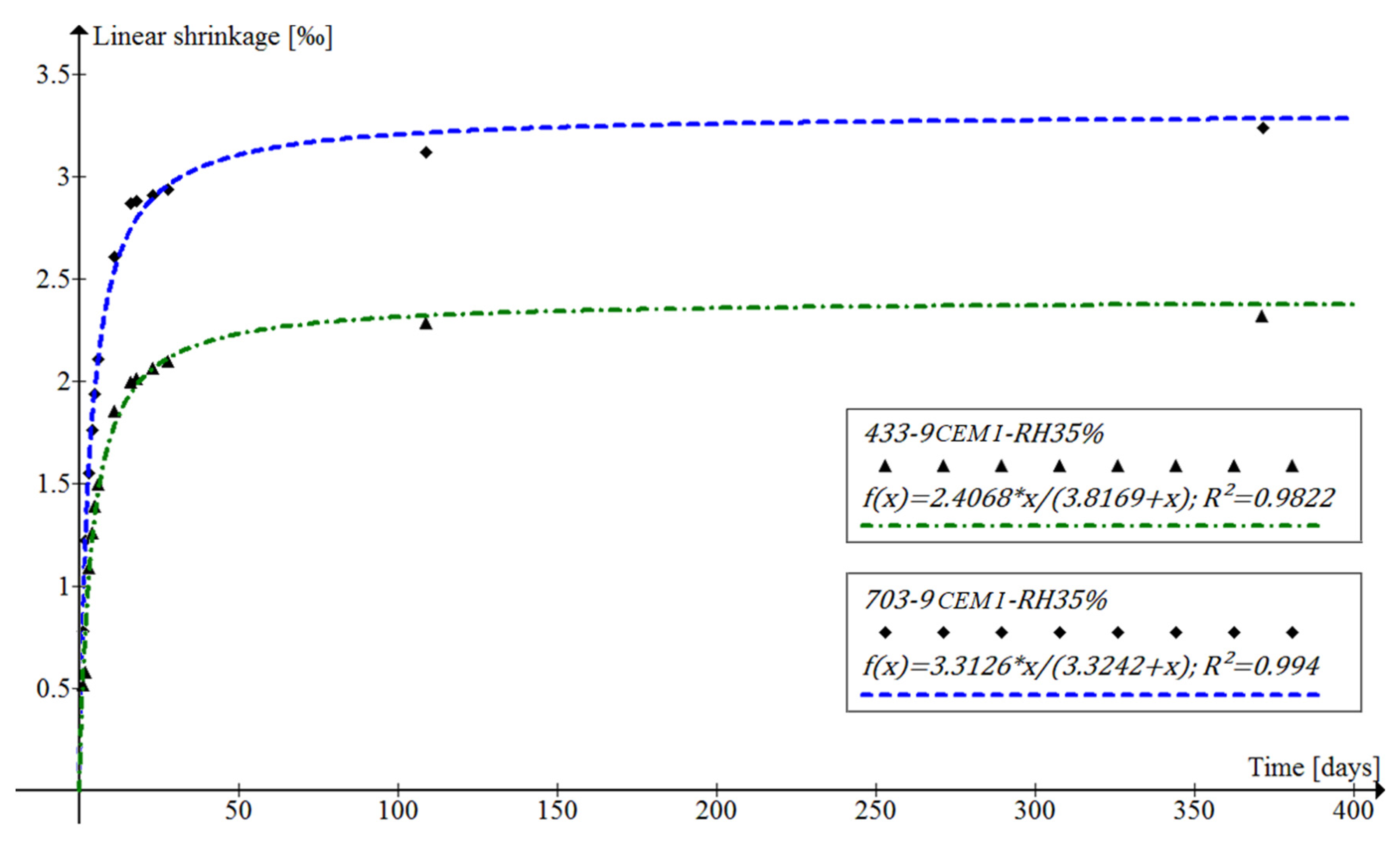

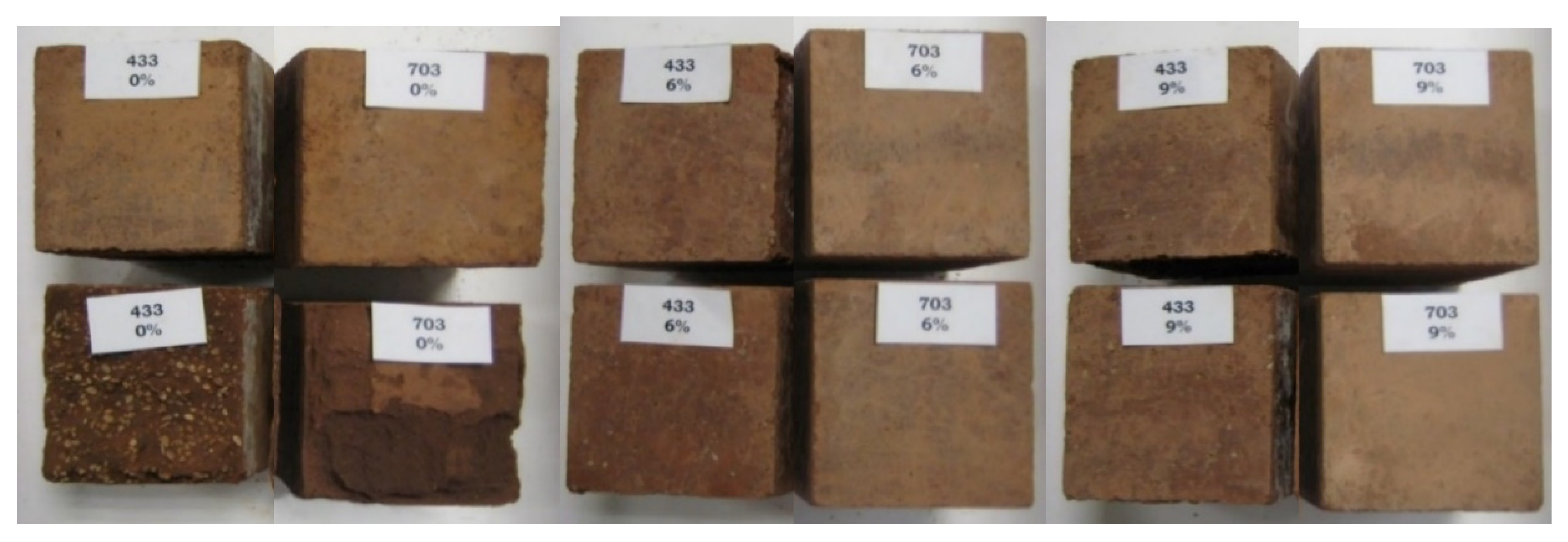
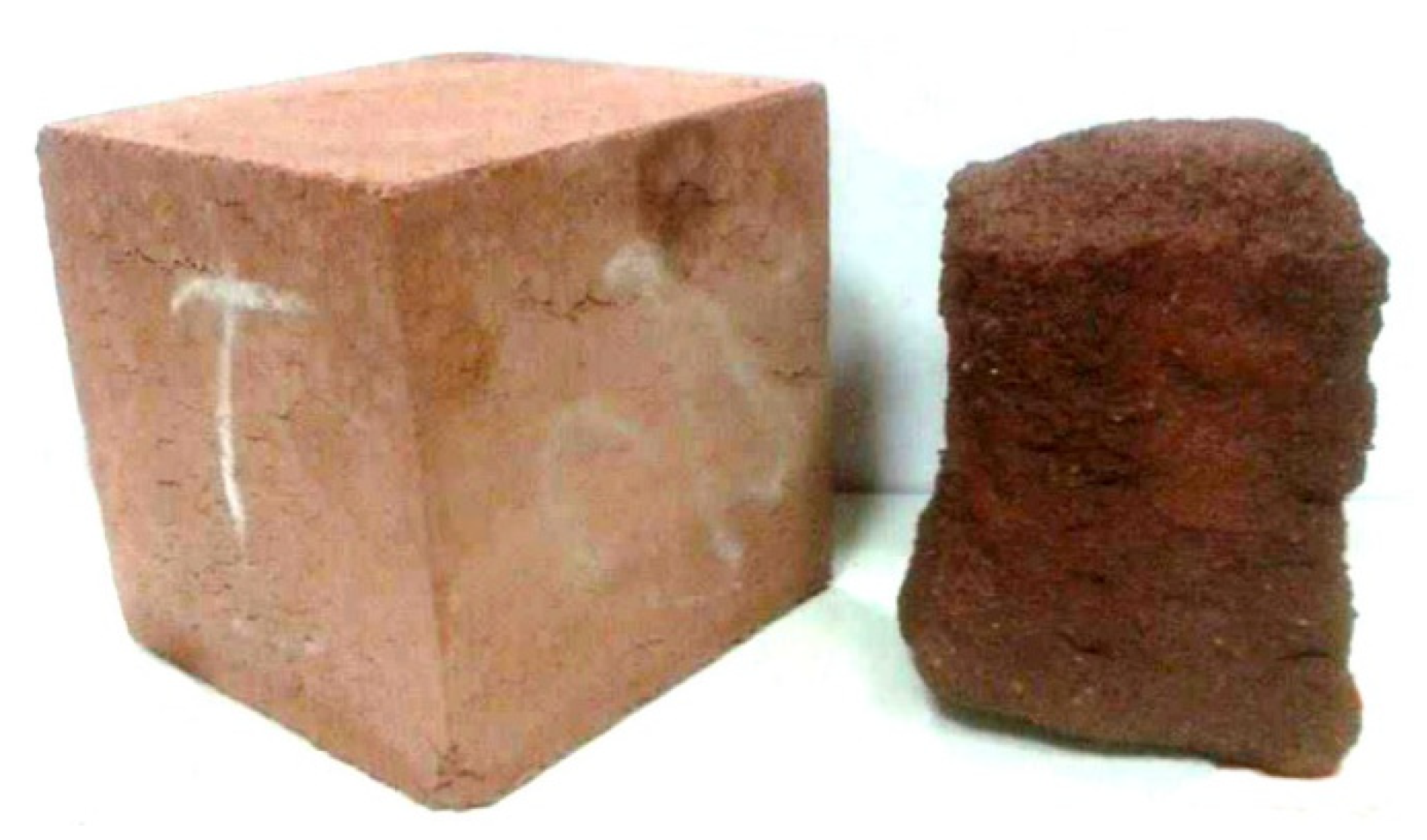
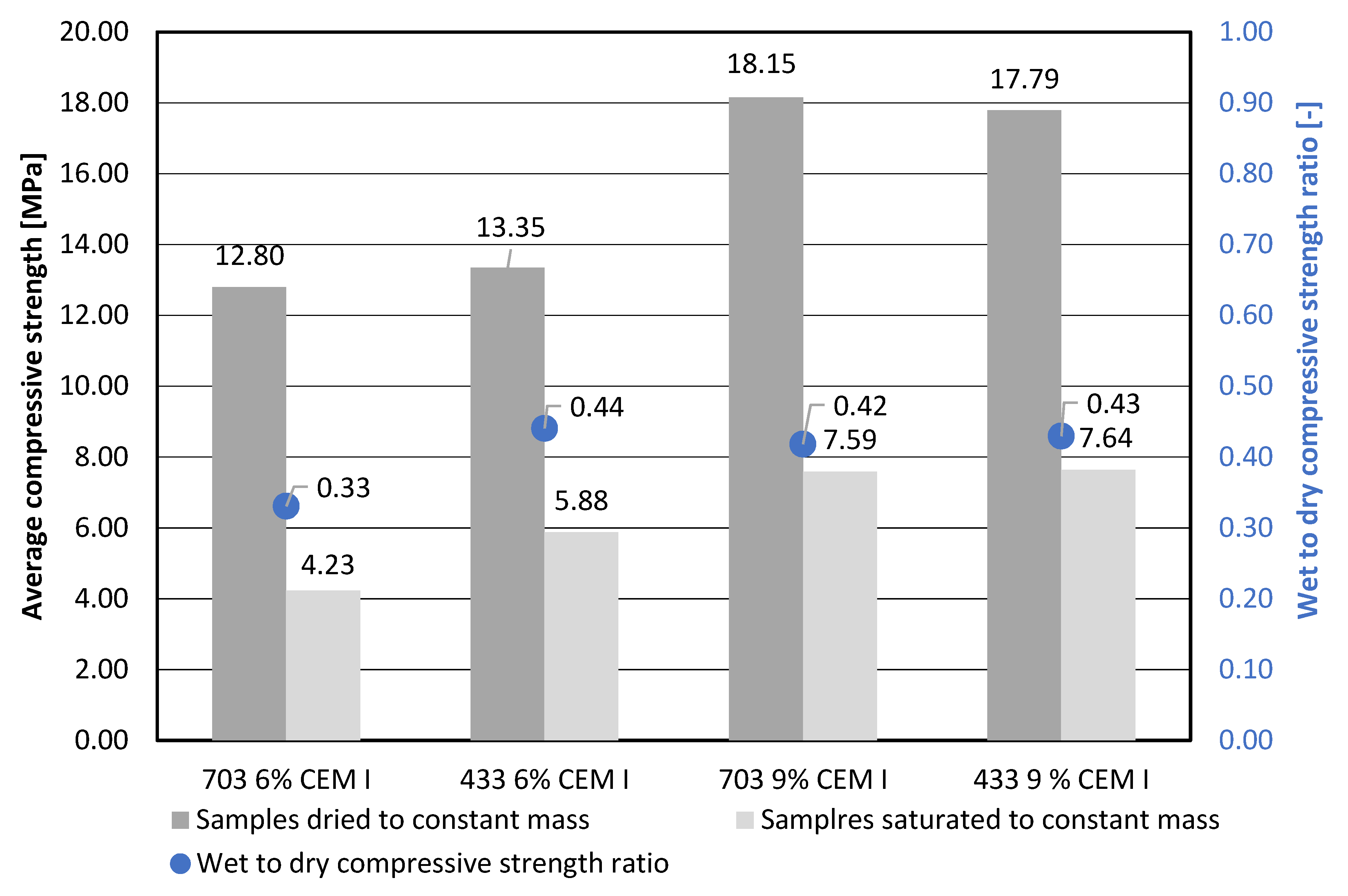
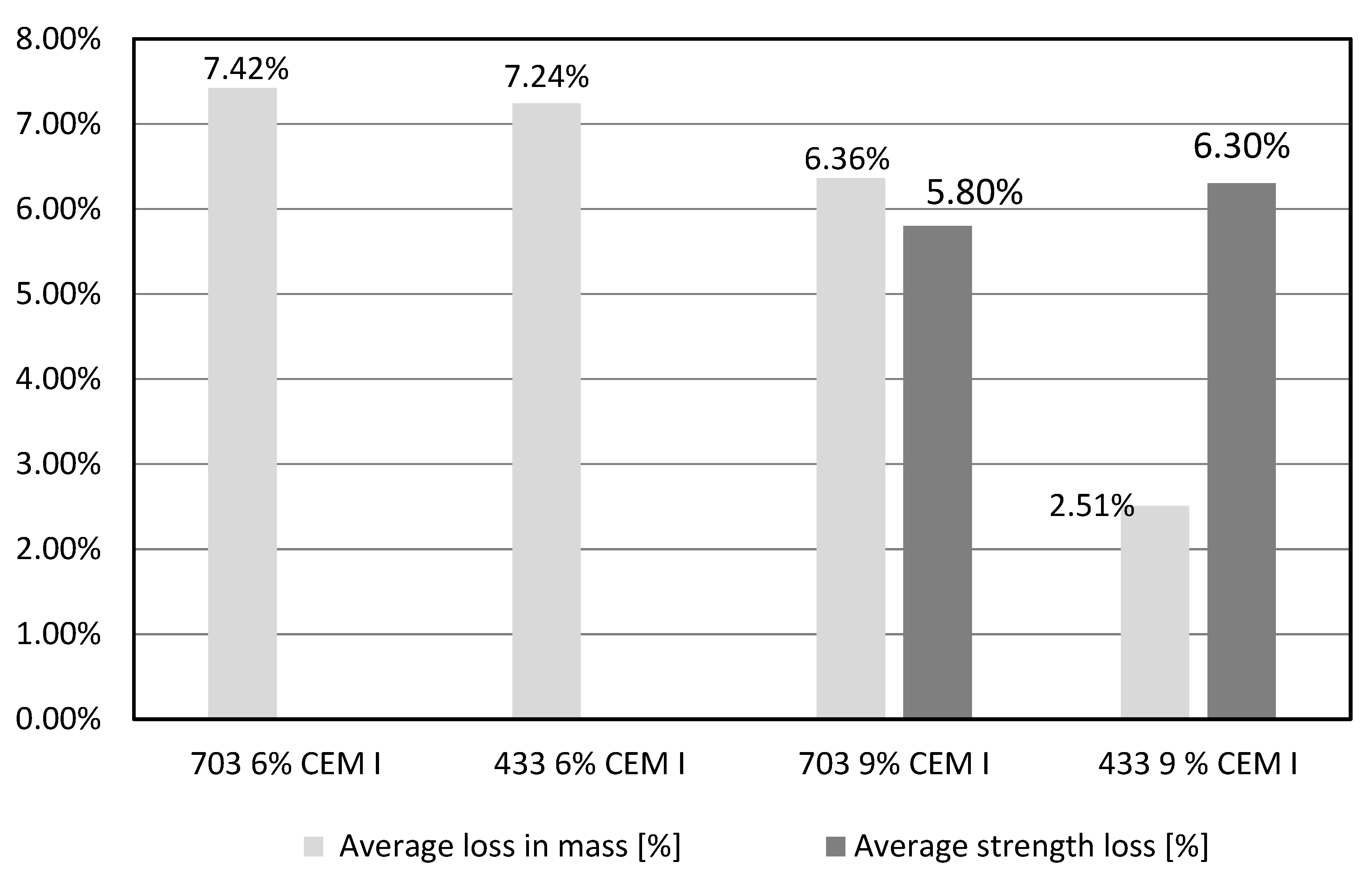
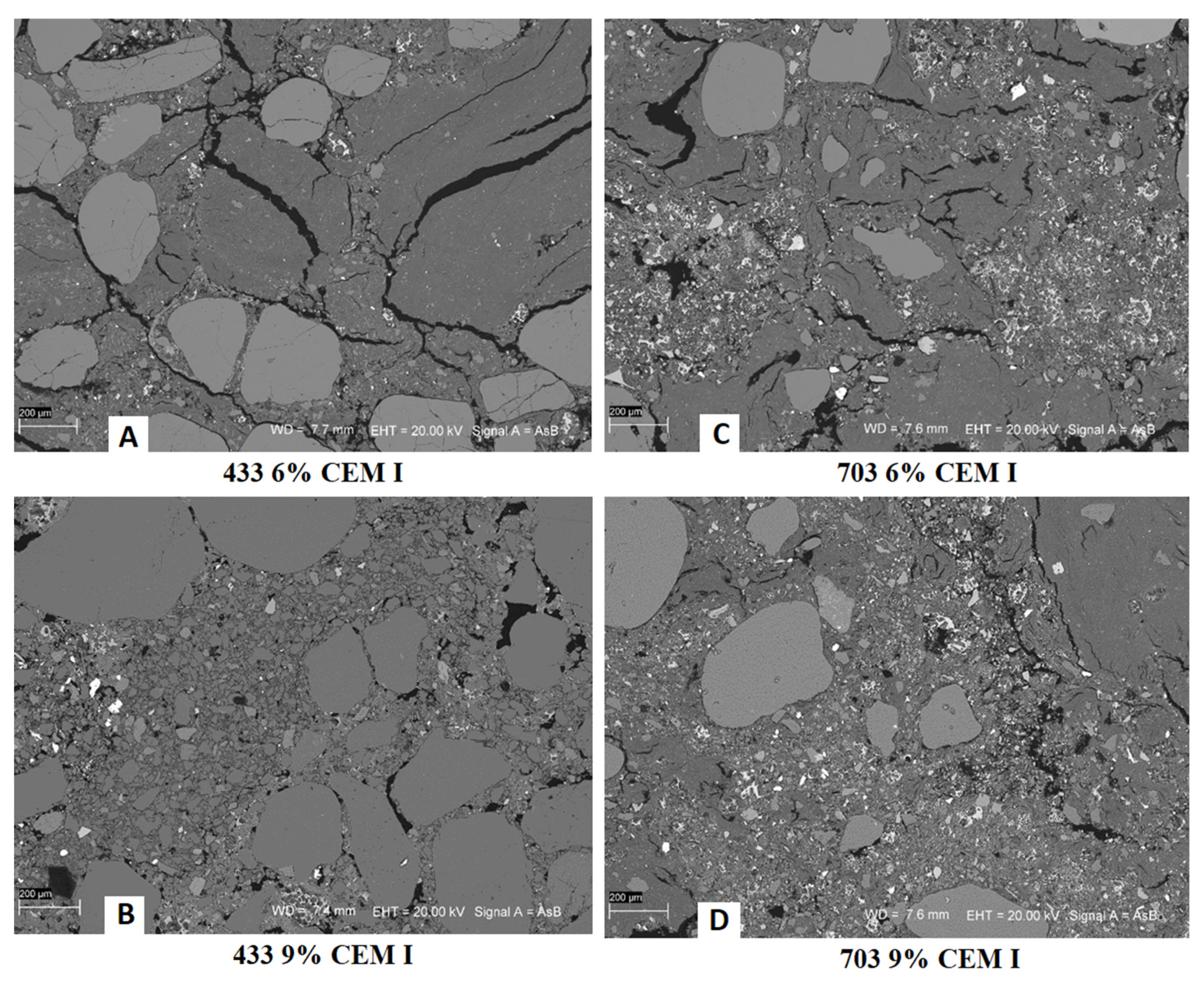
| Document | Ref. | Country | Properties of the Soil mixture | Properties of the Material | |||||||
|---|---|---|---|---|---|---|---|---|---|---|---|
| Mechanical Strength | Durability | ||||||||||
| Granulation | Organic substances | Soluble salts | Plasticity | Compressive strength | Tensile strength | Linear shrinkage | Frost resistance | Resistance to water | |||
| CSIRO Bulletin 5, 4th ed. (1995) | [15] | Australia | X | X | X | ||||||
| EBAA (2004) | [16] | X | X | X | |||||||
| HB 195-2002 | [17] | X | X | X | |||||||
| NBR 13553 (1996) | [18] | Brazil | The standard does not contain numerical requirements | ||||||||
| Lehmbau Regeln (2009) | [19] | Germany | X | X | X | X | |||||
| IS: 2110 (1998) | [20] | India | X | X | X | X | |||||
| IS: 13827 (1998) | [21] | X | X | ||||||||
| PCH-2-87 (1988) | [22] | Kyrgyzstan | X | X | X | X | |||||
| NZS 4297 (1998) | [23] | New Zealand | X | X | X | X | X | ||||
| NZS 4298 (1998) | [12] | ||||||||||
| NZS 4299 (1998) | [24] | ||||||||||
| 14.7.4 NMAC (2006) | [25] | USA | X | X | X | X | |||||
| ASTM 2392/E2392M (2010) | [26] | The standard does not contain numerical requirements | |||||||||
| ASTM D 560 (1996) | [27] | X | |||||||||
| ASTM D559 (2003) | [28] | X | |||||||||
| SAZS 724 (2001) | [29] | Zimbabwe | X | X | X | X | |||||
| BN-62/6738-01 | [30] | Poland | X | X | X | X | |||||
| BN-62/6738-02 | [31] | ||||||||||
| MOPT Tapial (1992) | [32] | Spain | X | X | X | ||||||
| Mineral Composition [%] | |||||||||||||
| Component | Clay Minerals | Including: | Goethite | Siderite | Carbonates | Organic substance | Quartz and other | ||||||
| Beidellite | Kaolinite | Illite | |||||||||||
| Content [%] | 43.7 | 8.9 | 8.6 | 26.2 | - | 6.0 | - | 0 | 50.3 | ||||
| Chemical composition [%] | |||||||||||||
| Component | SiO2 | Al2O3 | Fe2O3 | K2O | CaO | TiO2 | Other oxides | ||||||
| Content, [%] | 61.78 | 19.63 | 10.65 | 3.18 | 0.66 | 0.89 | 0.33 | ||||||
| Mixture Symbol | Sand | Gravel | Silt + Clay | Cement | Water |
|---|---|---|---|---|---|
| 703 0% CEM I | 1465 | 0 | 628 | 0 | 209 |
| 703 6% CEM I | 1391 | 0 | 596 | 119 | 211 |
| 703 9% CEM I | 1357 | 0 | 582 | 174 | 211 |
| 433 0% CEM I | 893 | 670 | 670 | 0 | 156 |
| 433 6% CEM I | 830 | 622 | 622 | 124 | 176 |
| 433 9% CEM I | 792 | 594 | 594 | 178 | 194 |
| Table | National Annex to PN-EN 206+A1 [51] | ASTM D 560 [27] |
|---|---|---|
| Maturation time of samples | 28 days | 7 days |
| Maturation conditions | Temperature 18 ± 2 °C, relative humidity above 90% | Temperature 21 °C ± 1.7 °C, relative humidity 100% |
| Shape and dimensions of samples | Cube with 100 mm side | Cylinder 102 mm in diameter and 116.4 mm in height |
| Preparation of samples for testing | Saturation of samples with water to constant mass | Drying of samples to constant mass at 110 °C |
| Temperature of freezing the samples | −18 ± °C | −23 °C |
| Time of freezing | 4 h | 24 h |
| Time of defrosting | 2–4 h | 23 h |
| Method of defrosting the samples | Defrosting in water with the temperature of 18 ± 2 °C | Defrosting in open air T= 21 °C ± 1.7 °C, RH = 100% |
| Number of freezing and defrosting cycles | Minimum 25 | 12 |
| Sizes tested | loss of weight in samples decrease in compressive strength | loss of weight in samples |
| Criteria for assessing resistance to frost | The samples do not show cracking, average loss in mass ≤5%, decrease in compressive strength ≤20%. | No guidelines |
| 0 % Cement | 6% Cement | 9% Cement | |||
|---|---|---|---|---|---|
| 703 | 433 | 703 | 433 | 703 | 433 |
| 0.46% | 0.42% | 0.36% | 0.34% | 0.33% | 0.24% |
| Test Time, [min] | 433 | 703 | 433 | 703 | 433 | 703 |
|---|---|---|---|---|---|---|
| 9% CEM I | 6% CEM I | 0% CEM I | ||||
| Depth of erosion D, mm | ||||||
| 15 | 1 | 0 | 1 | 0 | 3 | 24 |
| 30 | 1 | 1 | 2 | 0 | 9 | 33 |
| 45 | 1 | 2 | 2 | 0 | 15 | 45 |
| 60 | 1 | 2 | 2 | 0 | 20 | 53 |
| Ratio of susceptibility to water erosion | 1 | 1 | 1 | 1 | 2 | 3 |
| Test conditions set for Phase II | ||||||
| Time of water exposure in [min] | 4 | 4 | 4 | 4 | 2 | 1 |
| Number of cycles | 6 | |||||
| Composition of the Soil Mixture | Condition of the Surface of the Control Sample | Stage I | Stage II | ||
|---|---|---|---|---|---|
| Erodibility Ratio (from Table 7) | Time of Water Exposure | Changes of the Surface of the Sample after the Exposure | Result of the Verification Phase | ||
| 433 0% CEM | no damage | 2 | 6 × 2 min | deep losses on the surface of the whole sample | negative |
| 703 0% CEM | 3 | 6 × 1 min | |||
| 433 6% CEM | 1 | 6 × 4 min | no damage | positive | |
| 703 6% CEM | |||||
| 433 9% CEM | |||||
| 703 9% CEM | |||||
| Mixture Symbol | Montmorillonite [%] | Beidellite [%] | Kaolinite [%] | Illite [%] | Goethite [%] | Siderite [%] | Calcite [%] | Organic Substance [%] | Quartz and Others [%] | Cement Addition [%] | Compressive Strength [MPa] |
|---|---|---|---|---|---|---|---|---|---|---|---|
| MC III 6% | 0.0 | 6.6 | 1.9 | 0.0 | 0.9 | 0.0 | 13.1 | 0.1 | 77.3 | 6 | 6.96 |
| MC III 9% | 9 | 8.76 | |||||||||
| MC IV 6% | 0.0 | 0.0 | 21.8 | 0.0 | 0.3 | 0.0 | 0.0 | 0.1 | 77.8 | 6 | 4.51 |
| MC IV 9% | 9 | 5.63 | |||||||||
| MC V 6% | 0.0 | 0.0 | 21.1 | 0.0 | 0.0 | 0.0 | 0.0 | 0.1 | 78.7 | 6 | 4.30 |
| MC V 9% | 9 | 5.45 | |||||||||
| MC X 6% | 3.0 | 4.1 | 6.9 | 2.9 | 0.0 | 1.1 | 0.0 | 0.4 | 81.7 | 6 | 3.60 |
| MC X 9% | 9 | 4.27 | |||||||||
| Legend [%] | 0.1–1 | 1–5 | 5–10 | 10–25 | >25 |
| Criterion and Critical Value | 0 % Cement | 6% Cement | 9% Cement | |||||
|---|---|---|---|---|---|---|---|---|
| 703 | 433 | 703 | 433 | 703 | 433 | |||
| Linear shrinkage < 0.5% | 0.46% | 0.42% | 0.36% | 0.34% | 0.33% | 0.24% | ||
| Resistance to water erosion | Ratio of susceptibility to water erosion ≤ 2 | 3 | 2 | 1 | 1 | 1 | 1 | |
| Surface condition after exposure to water | Deep losses on the surface of the whole sample | No damage | ||||||
| Wet to dry compressive strength ratio > 0.33 | Not tested | 0.33 | 0.44 | 0.42 | 0.43 | |||
| Frost resistance after 25 cycles | Compressive strength decrease < 20% | Not tested | 100% | 100% | 5.8% | 6.3% | ||
| Mass loss < 5% | Not tested | 7.24% | 7.24% | 6.36% | 2.51% | |||
© 2020 by the authors. Licensee MDPI, Basel, Switzerland. This article is an open access article distributed under the terms and conditions of the Creative Commons Attribution (CC BY) license (http://creativecommons.org/licenses/by/4.0/).
Share and Cite
Narloch, P.; Woyciechowski, P. Assessing Cement Stabilized Rammed Earth Durability in A Humid Continental Climate. Buildings 2020, 10, 26. https://doi.org/10.3390/buildings10020026
Narloch P, Woyciechowski P. Assessing Cement Stabilized Rammed Earth Durability in A Humid Continental Climate. Buildings. 2020; 10(2):26. https://doi.org/10.3390/buildings10020026
Chicago/Turabian StyleNarloch, Piotr, and Piotr Woyciechowski. 2020. "Assessing Cement Stabilized Rammed Earth Durability in A Humid Continental Climate" Buildings 10, no. 2: 26. https://doi.org/10.3390/buildings10020026
APA StyleNarloch, P., & Woyciechowski, P. (2020). Assessing Cement Stabilized Rammed Earth Durability in A Humid Continental Climate. Buildings, 10(2), 26. https://doi.org/10.3390/buildings10020026






